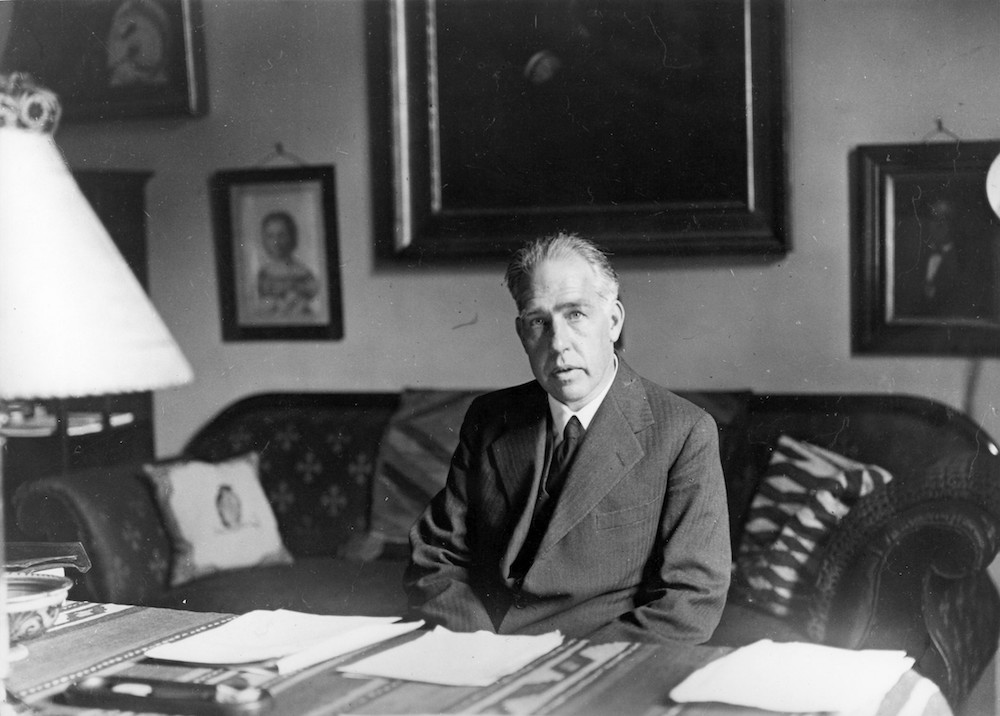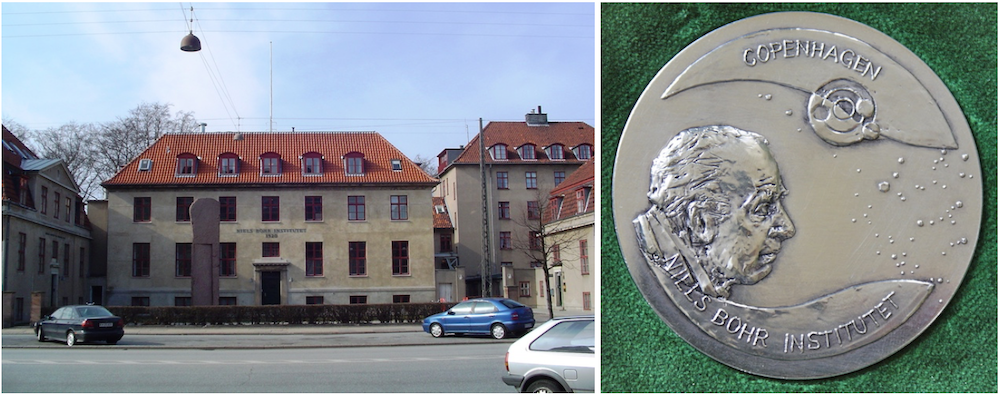
Danish physicist Niels Bohr is one of the most prominent physicists of the 20th century. He made great steps forward in understanding quantum theory and atomic structure, the latter of which earned him the Nobel Prize in Physics in 1922. As a philosopher and physicist, Bohr was a great supporter of scientific research, with his own research bringing us the Bohr model of the atom and the liquid droplet theory.
Niels Bohr’s Introduction to Theoretical Physics
Niels Bohr was born on October 7, 1885, in Copenhagen, Denmark. His family background set him up well for a career in science: His mother came from a family distinguished in education and his father was a well-known physiologist. Bohr took an early interest in physics, later pursuing his master’s and doctorate degrees at the University of Copenhagen. However, before he had any degree, Bohr demonstrated an extreme competence in physics.

A photograph of Niels Bohr. This work is in the public domain in its country of origin and other countries and areas where the copyright term is the author’s life plus 70 years or less, via Wikimedia Commons.
During Bohr’s collegiate education, the Academy of Sciences offered a prize for the solution to a specific scientific problem. This prompted him to produce an experimental and theoretical investigation of surface tension via oscillating fluid jets. For this work, Bohr received a gold medal, and his work was published in the Philosophical Transactions of the Royal Society (1908). This award was the first recognition of Bohr’s soon-to-be prolific career in theoretical physics.
The Bohr Model and Quantum Theory
In 1912, Niels Bohr worked at Ernest Rutherford’s laboratory at Manchester University. His research eventually led him to a close study of the structure of atoms on the basis of Rutherford’s discovery of the atomic nucleus. Bohr challenged the structure theorized by Rutherford and his collaborators, going on to develop the Bohr model of the atom by adapting Rutherford’s structure based on quantum mechanics. In a three-part series, he wrote that the electrons travel in separate orbits around a small, positively charged nucleus. In addition, the number of electrons in the outer orbit determine the element’s properties (some of which greatly help to organize the elements as they are discovered). The electrons would move from one orbit to another with lower energy, producing a light quantum. This explains why atoms emit light in fixed wavelengths.
An animation of Bohr’s model of the atom, including an electron making quantum leaps. Image by Kurzon — Own work. Licensed under CC BY-SA 3.0, via Wikimedia Commons.
Although the theory wasn’t perfect, the Bohr atomic model was a better fit for experimental evidence from other physicists. Over the years, Bohr’s base idea was proved to be correct, and he received the Nobel Prize in Physics in 1922. The atomic model is regarded as the top contribution Bohr made to physics, but it was not his only major contribution.
In his published essays from 1933 to 1962, Bohr formulated a concept called complementarity, which forms the basis of early quantum theory. The concept is twofold:
- An electron can be viewed either as a particle or wave
- Understanding of electron properties needs to have a foundation in empirical measurement
This concept emphasized that experimental results are directly impacted by the tools used to achieve them.
In the late 1930s, Bohr collaborated with a group of scientists working on the nuclear fission. Bohr presented his liquid droplet theory, which stated that a liquid drop accurately represents an atomic nucleus. This theory would become crucial in early attempts at splitting uranium atoms, which in turn were an important element in developing the atomic bomb.
World War II and the Manhattan Project
From 1913 to 1916, Niels Bohr held lectureships in physics at the University of Copenhagen and the Victoria University in Manchester. In 1916, he was appointed professor of theoretical physics at the University of Copenhagen, and in 1920, he became head of their Institute for Theoretical Physics. Though he retained this title for the rest of his life, the impact of World War II would pull Bohr away from the physical position.
Bohr was known for his compassion during wartime, donating his Nobel Prize to Finnish war efforts and providing refuge to German-Jewish physicists at the Institute in Copenhagen as Nazi occupation spread. Eventually, Bohr and his family had to flee Copenhagen as well. Bohr and one of his sons traveled to the U.S., where Bohr worked with the Manhattan Project in Los Alamos, New Mexico. Here, the first atomic bomb was being created, and Bohr raised concerns about the bomb’s potential uses. Even after the war ended, Bohr still called for peace in the uses of atomic energy. He helped to establish CERN in 1954, and helped to create the Atoms for Peace Conference in 1955.
Niels Bohr’s Legacy
Niels Bohr’s contributions to theoretical physics greatly shaped the future of atomic research. In addition to the Nobel Prize, Bohr received a number of other awards and recognitions for his works. The element bohrium was named after him, and the Institute for Theoretical Physics of the University of Copenhagen that Niels Bohr founded was named the Niels Bohr Institute in 1965.

Left: The Niels Bohr Institute in Copenhagen. Image by Thue and in the public domain via Wikimedia Commons. Right: A Niels Bohr Institute medal, featuring the physicist and his famous model of the atom. Image by Sigismundapo — Own work. Licensed under CC BY-SA 4.0, via Wikimedia Commons.
Let’s wish Niels Bohr a very happy birthday!
Further Reading
- Learn more about Bohr’s life and achievements:
- Read about other featured scientists:



Comments (0)